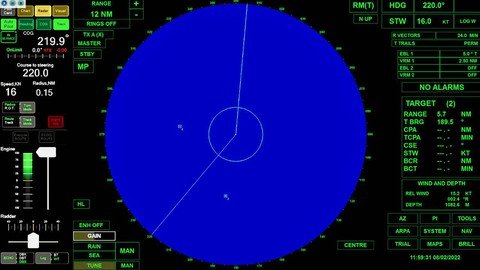
Last updated 9/2022
MP4 | Video: h264, 1280×720 | Audio: AAC, 44.1 KHz
Language: English | Size: 6.96 GB | Duration: 7h 16m
Using radar to navigate more safely on the water
What you’ll learn
Understand the principles of radar and operational controls of a commercial marine radar.
Understand the basics of relative motion, speed, distance, and time to aid in collision avoidance.
Understand the Collision Avoidance Regulations (COLREGS) as pertaining to marine radar.
Understand the use of marine radar for navigation.
Requirements
No experience is required, although learners with some time on the water or using a radar will benefit most from this course.
Description
This course is derived from a commercial course for Radar Observer for professional mariners, but tailored to an audience that suits all sailors and boaters. The course discusses the following concepts:Overview of radar theory and factors affecting radar performance.Operational controls for a radar, demonstrated by the Bridgemaster-E radar set, which is similar to many radar sets in modern navigation. Fundamentals of relative motion, speed, distance, and time, to help you better understand the power of radar as a navigational and collision avoidance tool.The Collision Avoidance Regulations (COLREGS) as pertaining to radar. The use of radar as a navigational tool for marine navigation. Advanced concepts of maneuvering boards and vector analysis for determining the course, speed, and closest point of approach of a nearby radar target. This course uses the Bridgemaster-E Radar and a maritime simulator to describe concepts and problems in maritime navigation. The course is based on the International Maritime Organization’s requirements for “Radar at the Operational Level” and is based on domestic USA courses such as “Radar Observer Unlimited” which often cost over $1000 dollars. The course is distilled and targeted for all mariners, but still includes challenging concepts and advanced details about radar and collision avoidance – it is not a cakewalk! The course does not discuss installation, power management, or operation of small recreational radars but instead uses commercial and professional discussions to help you understand radar at a fundamental level – helping you operate ANY radar more efficiently. The course is presented by Captain Chris Nolan, a licensed mariner at 1600/3000 Tons upon all oceans and a professional maritime instructor at a certified maritime training provider in the United States. Chris also sails as captain of tall ships in the United States and serves as a Coast Guard reservist.
Overview
Section 1: Introduction
Lecture 1 Introduction to the Course
Section 2: Principles of Radar
Lecture 2 Section Intro
Lecture 3 Fundamentals of Radar (Overview)
Lecture 4 (Optional) Deep Dive into Radar Principles
Lecture 5 Equipment Factors Affecting Radar (Overview)
Lecture 6 External Factors Affecting Radar
Lecture 7 (Optional) Deep Dive into Factors Affecting Radar Performance
Lecture 8 Demonstration of FTC and STC (Rain and Sea Clutter)
Lecture 9 Demonstration of Target Characteristics
Section 3: The Radar as a Tool for Mariners (Bridgemaster E Radar Example)
Lecture 10 Section Intro
Lecture 11 Transmitting and Radar Presentations
Lecture 12 Vectors and Target Trails
Lecture 13 Relative vs. True Vector Example
Lecture 14 8 Step Tuning Process
Lecture 15 Menu and Centering
Lecture 16 Other Operational Controls and EBL/VRM
Lecture 17 Introduction to AIS and ARPA
Lecture 18 Target Acquisition and AZ Guard Zones
Section 4: Radar as a Tool for Relative Motion
Lecture 19 Section Introduction
Lecture 20 Fundamentals of Speed, Distance, and Time
Lecture 21 Introduction to the Maneuvering Board
Lecture 22 Vectors and Maneuvering Board Lingo
Lecture 23 Relative Motion and Closest Point of Approach
Lecture 24 Speed and Direction of Relative Motion on a Maneuvering Board
Lecture 25 Demonstration (Dead Ahead – Radar)
Lecture 26 Demonstration #1 (Dead Ahead – Maneuvering Board)
Lecture 27 Demonstration #2 (Reciprocal Courses – Radar)
Lecture 28 Demonstration #2 (Reciprocal Courses – Maneuvering Board)
Lecture 29 Demonstration #3 (Same Course/Speed – Radar)
Section 5: Radar as a Tool for Collision Avoidance
Lecture 30 Section Introduction
Lecture 31 Rule 2 Discussion
Lecture 32 Rule 4 Discussion
Lecture 33 Rule 5 Discussion
Lecture 34 Rule 6 Discussion
Lecture 35 Rule 7 Discussion
Lecture 36 Rule 8 Discussion
Lecture 37 Rule 19 Discussion
Lecture 38 Radar Demonstration of Head On Situation
Lecture 39 Radar Demonstration of Crossing Situation
Lecture 40 Radar Demonstration of Overtaking Situation
Section 6: Radar as a Tool for Maritime Navigation
Lecture 41 Introduction to Radar Navigation
Lecture 42 The Radar Fix
Lecture 43 Turn Ranges
Lecture 44 Tangent Bearings
Lecture 45 Parallel Indexing
Lecture 46 Radio Beacon (RACON)
Lecture 47 Search and Rescue Transponder (SART)
Section 7: Advanced Techniques on Maneuvering Boards (Optional Content)
Lecture 48 Section Introduction
Lecture 49 CPA Discussion
Lecture 50 CPA Calculations
Lecture 51 Course and Speed Discussion
Lecture 52 Course and Speed Calculation (Transfer)
Lecture 53 Course and Speed Calculation (Rapid)
Lecture 54 Avoidance (Transfer)
Lecture 55 Avoidance (Rapid)
Lecture 56 Intercept
Lecture 57 Trail Maneuvers and Course Change Demonstration
Section 8: Conclusion and Takeaways
Lecture 58 Key Takeaways from the Course
This course is intended for recreational or commercial mariners, sailors and boaters looking to understand more about marine radar. This course is taught to a professional standard, but tailored for the audience.
Password/解压密码www.tbtos.com